

Climbing plants are the way to go to decorate gardens that aren’t that big. They easily replace a wider hedge, and don’t require much care.
Additionally, lush leafage tends to cool the area around it, cancelling the usual heat bubble that forms along walls in the summertime. The area that needs covering is an important factor, it guides you in selecting the right plant from the many possibilities.
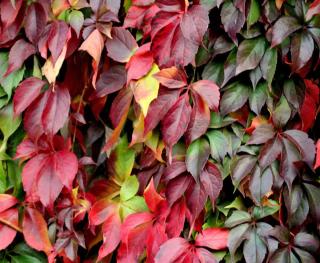 Ivy and virginia creeper are excellent to decorate the front of your house. Exposure doesn’t matter to them, and they also don’t need any help latching on to the walls. Virginia creeper climbs on the most difficult types of walls thanks to its suction-cup like organs, and ivy has a special way of locking its roots in tiny holes exactly like expansion bolts in modern homes.
Ivy and virginia creeper are excellent to decorate the front of your house. Exposure doesn’t matter to them, and they also don’t need any help latching on to the walls. Virginia creeper climbs on the most difficult types of walls thanks to its suction-cup like organs, and ivy has a special way of locking its roots in tiny holes exactly like expansion bolts in modern homes.
Ivy (Hedera helix) has evergreen foliage, making it a permanent fixture int the garden, whereas Parthenocissus (tricuspidata and quinquefolia ‘Engelmanii’) reveal their flamboyant beauty in fall with their bright red leaves.
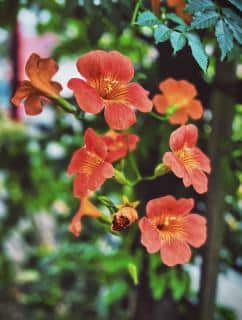 Walls covered in flowers are definitely very appealing. Trumpet vine is an excellent choice for regions where the summer gets hot.
Walls covered in flowers are definitely very appealing. Trumpet vine is an excellent choice for regions where the summer gets hot.
Select Campsis radicans or x tagliabuana ‘Mrs Gallen’, both have enough tendrils to fasten themselves to walls, unlike Campsis grandiflora.
If winds scour the area, you’ll have to provide some type of structure, though.
With a simple mesh wire lattice, or a cute wooden frame, small-flowered clematis and Clematis armandii can also climb as high as you want them to reach.
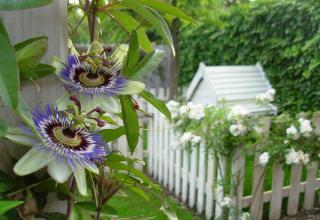 Passion flower Passiflora caerulea is a very powerful and hardy vine that uses corkscrew tendrils to hoist itself up, so you’ll need to provide something for them to twine around. Its large star-like flowers aren’t very common, and the bright orange fruits that appear thereafter stay very ornamental until fall.
Passion flower Passiflora caerulea is a very powerful and hardy vine that uses corkscrew tendrils to hoist itself up, so you’ll need to provide something for them to twine around. Its large star-like flowers aren’t very common, and the bright orange fruits that appear thereafter stay very ornamental until fall.
It grows in full sun, or in part sun when the climate suits it well. In case of deep freezing, it can sprout back from the stump if airborn parts died off.
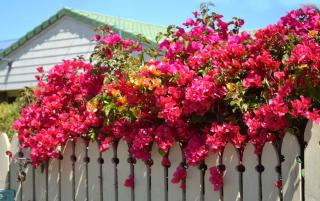 Along the coast, one that absolutely deserves mentioning is bougainvillea.
Along the coast, one that absolutely deserves mentioning is bougainvillea.
It is hardy down to 17°F (-8°C) for the hardiest variety: Bougainvillea ‘Violet de Meze’ which bears small prune-colored flowers.
Tether the plant to the wall because its thorns and spikes aren’t enough to keep it latched to walls.
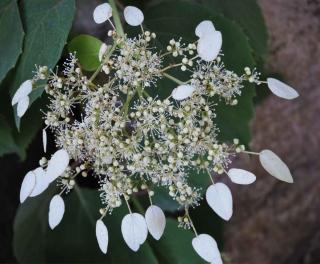 Blooming isn’t reserved to sunny locations: shady walls also get their own flowers. Make the most of cool acidic soil and plant climbing hydrangea (Hydrangea petiolaris).
Blooming isn’t reserved to sunny locations: shady walls also get their own flowers. Make the most of cool acidic soil and plant climbing hydrangea (Hydrangea petiolaris).
Its shiny foliage showcases bright and luminous creamy white corymbs that are 6 to 8 inches across (15 to 25 cm), from end of May to beginning of July.
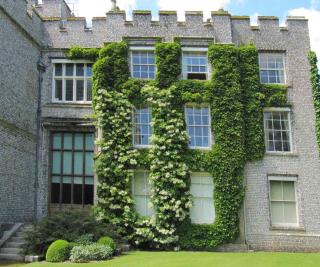 Schizophragma hydrangeoides, which loves cool soil (even if limestone) is just as interesting to cover a wide expanse (over 30 feet tall or 10 meters) that’s in part or full shade.
Schizophragma hydrangeoides, which loves cool soil (even if limestone) is just as interesting to cover a wide expanse (over 30 feet tall or 10 meters) that’s in part or full shade.
Its deciduous foliage, dark green on the topside, silvery and covered with fuzz on the underside, unfurls white or pink (‘Roseum’ cultivar) blades that are 2 inches long at the beginning of summer.
It blooms in summer but isn’t fragrant.
All climbing plants, whether with tendrils or twining stems, will do great along a fence: they only need a little help to reach the top of the structure at the beginning. Once the main trunk has thickened, branches twist and climb into one another, dropping off along both sides of the wall or fence. It’s easy to contain the most vigorous growers with a pair of shears, snipping any branches off as they grow too long.
In the fragrant climbing plant group, honeysuckles like Lonicera periclymenum and japonica are among the most famous.
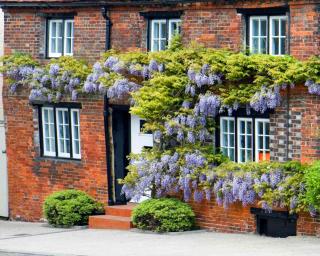 Wisteria (Wisteria sinensis) is a classic that always sends out abundant clusters of fragrant flowers in April-May, with a few new flowers appearing over the summer. However, don’t plant it near a house, and not under a gutter, because its roots and branches will damage the structures in the end. Keep it for side walls and fences.
Wisteria (Wisteria sinensis) is a classic that always sends out abundant clusters of fragrant flowers in April-May, with a few new flowers appearing over the summer. However, don’t plant it near a house, and not under a gutter, because its roots and branches will damage the structures in the end. Keep it for side walls and fences.
In milder regions (coldest 10°F or -12°C), the heady scents of star jasmine will attract attention in May-June. This evergreen climber, with hints of purple around leaf edges during winter, Trachelospermum jasminoides, will wrap itself around any type of structure or trellis. It’s also suitable for growing in a large pot that you can bring indoors in winder.
Medicinal jasmine (Jasminum officinalis), a typical plant around the Mediterranean, would also work wonders in other regions as well. It resists -4°F (-20°C), so all you need to worry about is to give it a spot that is well endowed with sunlight and well drained soil.
Clematis of all sorts will provide you with an astounding range of colors, flower shapes, and blooming seasons. Thanks to the thin but robust stems, they can colonize any type of arbor. Those with large flowers don’t grow as big, and will only cover about 5-6 square yards or meters. Plant them in the sun, but protect the base with shade.
Ornamental kiwi (Actinidia kolomikta) appeals to many thanks to its mottled pink and cream leaves in spring. Solanum jasminoides, reserved for mild climates, might even bend over because of the overload of immaculate white or purple flower clusters.
Try out Wattakaka sinensis which can cover about 8-10 square yards/meters and resists 5°F (-15°C). Its abundant heart-shaped foliage is covered in bouquets of pink to white flowers. Very fragrant in June-July.
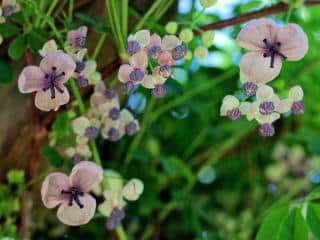 Adopt Chocolate trumpet vine Bignonia capreolata for its chocolatey-coffee-like smell! Uphold the branches at the beginning so that the tendrils can find somewhere to fasten themselves to.
Adopt Chocolate trumpet vine Bignonia capreolata for its chocolatey-coffee-like smell! Uphold the branches at the beginning so that the tendrils can find somewhere to fasten themselves to.
Akebia quinata bears curious clusters of wine-colored flowers, delicately fragrant, with foliage that’s all light green, roundish leaflets.